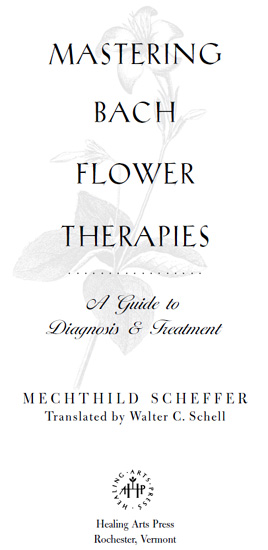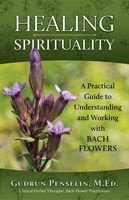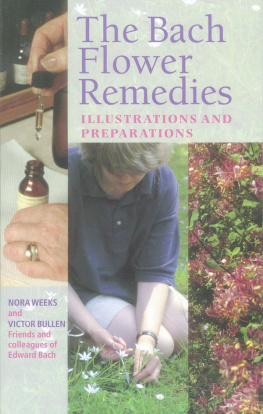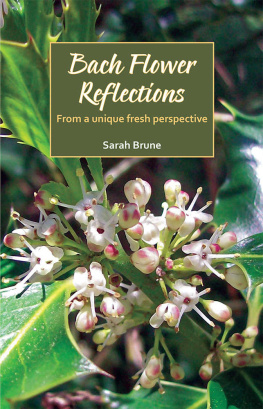
A flower that opens makes no noise. On light soles beauty, luck, and heroism wander. Anything that is to have permanence in this noisy world of fake heroism, false luck, and untrue beauty shall come imperceptibly.
Wilhem Raabe
Whether the masses of millionshaving material strength and means that appear so fruitful and unshakeablewill triumph in history will be due not to money, the sword, or power, but to the beginnings of hardly perceptible thoughts of seemingly unimportant people.
Dostoyevsky
PREFACE
This book is a continuation and addition to Bach Flower Therapy and should be read in connection with it. It contains a small but representative group of firsthand experiences with Bach Flower Therapies in Germany, Austria, and Switzerland. To all the friends of the Bach Flowers this books practical applications will bring about encouraging insight and valuable recognition and it will reveal the wide spectrum of flowers that heal through the soul.
The contributions
In reading the hundreds of contributions I was deeply touched, and I would like to thank all those who have supported Edward Bachs idea of healing through the soul and with it the concept of human dignity in relation to illness and health.
After the release of Bach Flower Therapy, readers of that book recognized themselves in many flower descriptions, but found they experienced difficulty in deciding which flower to assign priority to in a given situation.
The practical diagnostic questionnaire supplied in the appendix of this bookprimarily developed for Bach Flower Therapyshould, particularly for the beginner, facilitate the choice of a relevant flower combination. A shorter version can be obtained by doctors and naturopaths for their patients through the Dr. Edward Bach Centre.
For information and advice concerning the use and purchase of essences of flowers or regarding Bach Flower seminars, and for all other inquiries about Bach Flower Therapies please contact the following:
England
Bach Flower Remedies Ltd.
Dr. Edward Bach Center
Mount Vernon
Sotwell, Wallingford
Oxfordshire OX10 0PZ
England
Tel: 0491 39489/34678
North America
Ellon (Bach USA), Inc.
P.O. Box 320
Woodmere, NY 11598
USA
Tel: (516) 593-2206
Australia
The Pharmaceutical Plant Company
P.O. Box 68
Bayswater, Victoria 3153
Australia
03-7628577/8522
Martin & Pleasance Wholesale Pty Ltd.
P.O. Box 4
Collingwood, Victoria 3066
Australia
Tel.: 419-9733
An important note for the reader: The system of the thirty-eight Bach Flowers can act as an aid to self-healing, allowing you to take hold of transitory negative moods such as uncertainty, jealousy, faintheartedness, and others brought on by weakness of character. The goal of therapy is purification of the soul, self-realization, harmonious development, and greater personal stability. An indirect result is a lighter resistance to psychic and psychosomatic disturbances. It would be therefore erroneous to make a direct connection between the effect of the thirty-eight Bach Flowers and physical symptoms of illnesses. Bach Flower Therapy is more suited to the field of spiritual health provision.
While Bach Flower Therapy might serve in the prevention of physical illnesses and as a support to a more traditional specialized medical therapy, it should not replace it. When we discuss factors such as diagnosis, patient, therapy, or healing regarding Bach Flower Therapy it should not be interpreted as a prescription. Readers should also understand that Bach Flower Therapy cannot be used in place of treatment by a qualified medical practitioner.
HEALING THROUGH THE SOUL
An Introduction to Bach Flower Therapy
When someone is sick he feels and thinks differently. Compared to a healthy person, he may be jittery, resigned, bitter, stubborn, or impatient. As Edward Bach proposed sixty years ago, the patients consciousness has undergone a negative change by turning away from its higher self and the laws of its soul. In contrast, a positive change in consciousnessapart from treatments modern medicine might provideis the deciding factor in every healing process; therefore, every crisis or illness offers us the chance for a positive character change, a step to maturity, a quantum leap in character development.
Edward Bach, among others, observed that with every medically definable illness negative moods such as impatience, despair, and hopelessness become apparent. What is decisive, though, is the fact that every medically definable illness is at some time preceded by such negative moods. If such negative moods can be recognized early on and made positive, physical illness may be prevented altogether.
Today, if one is in a position to take a clear look at our environment, one will notice with horror that a large part of the population of our so-called civilized countries is approaching a state of collective illness. Feelings of resignation, hopelessness, fear, depression, confusion, and helplessness abound and are determining the general feel of life, especially in the younger generation. Perhaps that is why these young people have characteristically been the quickest to recognize and embrace the message of an English physician who combined the abilities of a scientist with those of a modern shaman. Sixty years ago Edward Bach recognized that certain plants have the energetic potency to target negative moods in a subtle way without influencing them arbitrarily. He called them happy fellows of the plant world, and they served as catalysts for the transformation of negative consciousness into positive consciousness, allowing a profound connection with ones higher self.
Initially viewed with skepticism and the subject of ridicule, Bach Flower Therapy has now become for many people their salvation; it has changed their fate. The following letter from a young Swiss is representative of many others:
I was born on a farm in Eastern Switzerland, the second of six children. My mother had wished for a girl, but I turned out a boy. Shortly after birth, I developed an eye infection and so I became the problem child of the family. My father tried to break my strong will through punishment and beatings. I had a very hard childhood and I was very defiant. During puberty I often thought of suicide. After school, I worked for a year on the family farm; I was practically forced to do that. After the year passed, I worked as a letter carrier for the post office. I wanted to get away from the house as soon as possible.
After a year at the post office I got a job with an insurance company. I stayed there for five years. During this time I studied each Saturday in order to obtain a commercial degree. When I was nineteen, I met a man who was thirteen years older and I was drawn to him. My mother was outraged and there were dramatic scenes. But I had my way. Shortly after my departure I also changed jobs. I went to a large bank where I was hired as a computer operator.
The early days with my friend brought many problems. As pressures from home disappeared, many things that had not been dealt with came to the surface. I couldnt manage them by myself. On the advice of my doctor and my friend, I started psychiatric care. My psychiatrist found strong manic-depressive states. He said that it was in my family, that I carried a heavy, hereditary burden. I was on various medications for five years, including Lithium.
For a while I was balanced by the medications. But deep inside of me trouble continued to boil. I started working intensely, as if work was a drug to which I was addicted. I worked at home in the garden, bought animals, half of a farm, all this on top of the work in my office. The drug was outstanding. After fifteen to eighteen hours of work, I would sink into a deep sleep, and all my real problems would seem to move aside. But inside, these pressures took their toll. And so, three years ago, I collapsed and had to be taken to the hospital. I was operated on twice for various cancers, and subsequently underwent twenty sessions of radiation.
Next page










